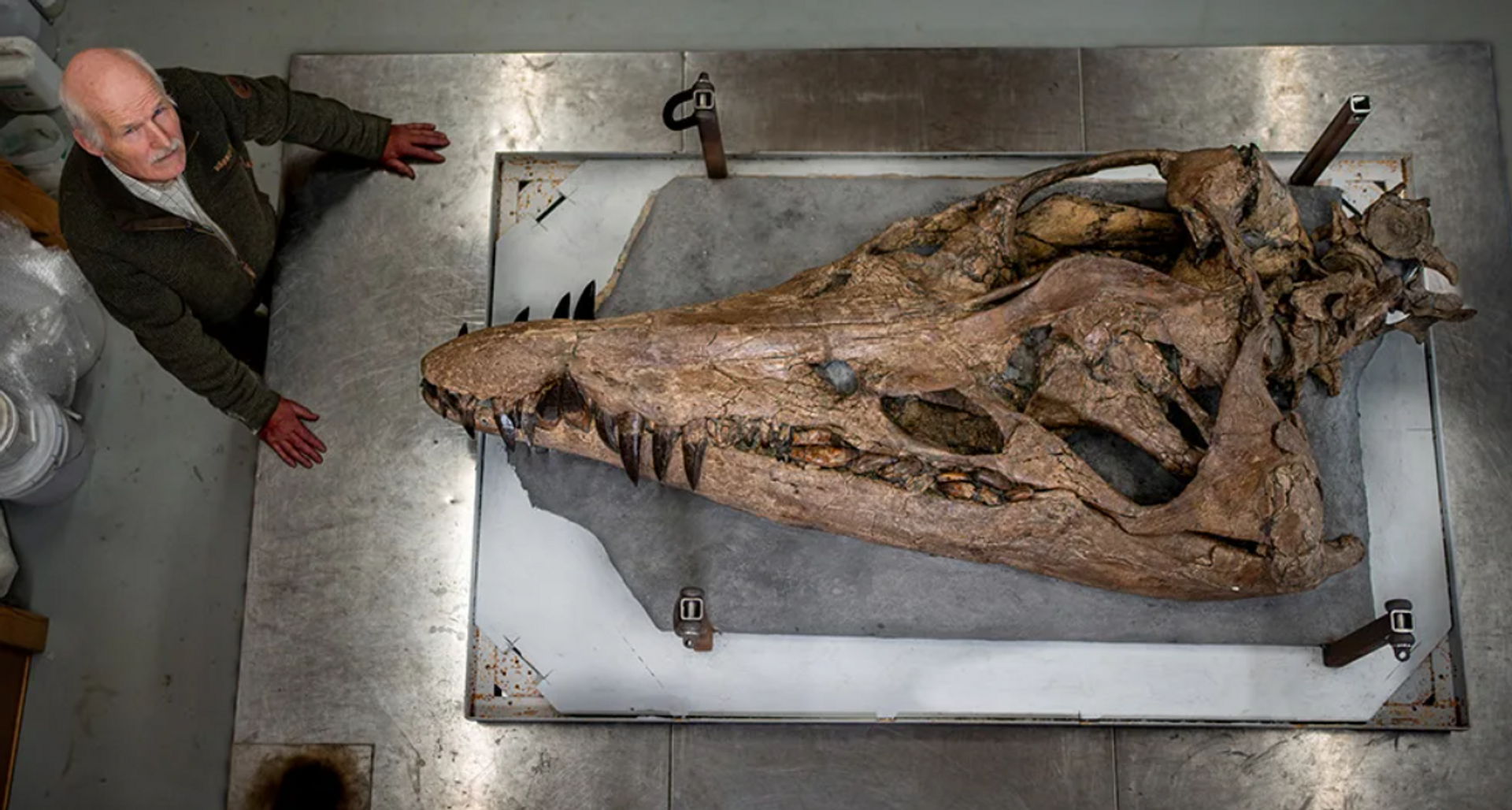https://sputnikglobe.com/20231210/oceanic-t-rex-giant-pliosaur-skull-discovered-off-uks-jurassic-coast-1115508409.html
Oceanic T. Rex: Giant Pliosaur Skull Discovered off UK's Jurassic Coast
Oceanic T. Rex: Giant Pliosaur Skull Discovered off UK's Jurassic Coast
Sputnik International
The new two-meter-long fossil is believed to be one of the most complete specimens of its kind ever found and could provide new insights into this ancient predator.
2023-12-10T11:23+0000
2023-12-10T11:23+0000
2023-12-10T11:23+0000
beyond politics
science & tech
society
dorset
fossils
discovery
paleontology
paleontologists
https://cdn1.img.sputnikglobe.com/img/07e7/0c/0a/1115508833_3:0:1192:669_1920x0_80_0_0_bdb35fe170f12e6c0d8d828c6ac38126.png
A colossal sea monster's skull has been unearthed in a recent discovery along Dorset's coast. It belonged to a ferocious pliosaur that prowled the ancient oceans 150 million years ago.Local paleontologist Steve Etches described it as "one of the best fossils I've ever worked on," highlighting its unparalleled completeness with the lower jaw and upper skull still meshed together.The massive skull, longer than most humans are tall, showcases 130 razor-sharp teeth capable of delivering lethal bites. At 10-12 meters in length, the pliosaur was a dominant apex predator, often likened to an underwater T. Rex.Discovered near Kimmeridge Bay in Dorset, UK, the fossil's recovery involved a daring effort, with enthusiasts Phil Jacobs and Steve Etches creating a makeshift stretcher to transport the heavy snout tip to safety. A drone survey identified the cliffside location, leading to a delicate extraction process that involved abseiling down a 15-meter cliff.Scientists anticipate gaining fresh insights into the pliosaur's lifestyle and domination from this extraordinary discovery. Palaeobiologist Prof. Emily Rayfield has already examined the skull, revealing insights into the pliosaur's powerful bite and feeding strategies.The skull's features, such as small pits on the snout and a hole for a third eye, suggest heightened senses, potentially aiding in prey detection and navigation in murky waters.Etches plans to display the skull at his museum in Kimmeridge, emphasizing the urgency of completing the extraction due to the rapidly eroding cliffside. According to him, it's a "once-in-a-lifetime opportunity" to unveil more of this ancient sea monster before it is lost to the forces of time.
dorset
Sputnik International
feedback@sputniknews.com
+74956456601
MIA „Rossiya Segodnya“
2023
Sputnik International
feedback@sputniknews.com
+74956456601
MIA „Rossiya Segodnya“
News
en_EN
Sputnik International
feedback@sputniknews.com
+74956456601
MIA „Rossiya Segodnya“
Sputnik International
feedback@sputniknews.com
+74956456601
MIA „Rossiya Segodnya“
t. rex, pliosaur, uk map jurassic coast, dorset jurassic coast, steve etches discovery, steve etches dorset, jurassic coast uk fossils
t. rex, pliosaur, uk map jurassic coast, dorset jurassic coast, steve etches discovery, steve etches dorset, jurassic coast uk fossils
Oceanic T. Rex: Giant Pliosaur Skull Discovered off UK's Jurassic Coast
The new two-meter-long fossil is believed to be one of the most complete specimens of its kind ever found and could provide new insights into this ancient predator.
A colossal sea monster's skull has been unearthed in a recent discovery along Dorset's coast. It belonged to a ferocious pliosaur that prowled the ancient oceans 150 million years ago.
Local paleontologist Steve Etches described it as "one of the best fossils I've ever worked on," highlighting its unparalleled completeness with the lower jaw and upper skull still meshed together.
The massive skull, longer than most humans are tall, showcases 130 razor-sharp teeth capable of delivering lethal bites. At 10-12 meters in length, the pliosaur was a dominant apex predator, often likened to an underwater
T. Rex.
Discovered near Kimmeridge Bay in Dorset, UK, the fossil's recovery involved a daring effort, with enthusiasts Phil Jacobs and Steve Etches creating a makeshift stretcher to transport the heavy snout tip to safety. A drone survey identified the cliffside location, leading to a delicate extraction process that involved abseiling down a 15-meter cliff.
Scientists anticipate gaining fresh insights into the pliosaur's lifestyle and domination from this extraordinary discovery. Palaeobiologist Prof. Emily Rayfield has already examined the skull, revealing insights into the pliosaur's powerful bite and feeding strategies.
The skull's features, such as small pits on the snout and a hole for a third eye, suggest heightened senses, potentially aiding in prey detection and navigation in murky waters.
Etches plans to display the skull at
his museum in Kimmeridge, emphasizing the urgency of completing the extraction due to the rapidly eroding cliffside. According to him, it's a "once-in-a-lifetime opportunity" to unveil more of this ancient sea monster before it is lost to the forces of time.




